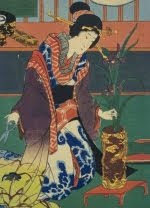"Once a flower is cut, it must be set by someone who understands the language of the flower. Just as musicians express themselves through the language of music, ikebana artists must use the language of the flowers. Creating good ikebana meens becoming fluent in this language. ... This is what ikebana means - always facing flowers with candor and listening to what they say."
Sofu Teshigahara, founder of the Sogetsu School of ikebana,
from "Kadensho; The Book of Flowers"
from "Kadensho; The Book of Flowers"
Rowan and purple wild flowers.


























